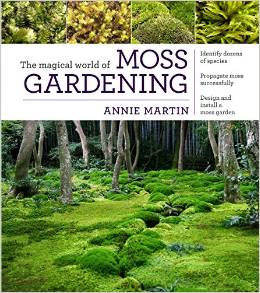Go Green With Mosses
By George Graine, Fairfax Master Gardener
Many things grow in the garden that were never sown there.
—Thomas Fuller in Gnomologia (1732)

A peaceful place in the Kathleen Smith Moss Garden at Duke University
Annie Martin (aka Mossin’ Annie), author of The Magical World of Moss Gardening (Timber Press, 2015) may convince you to give moss another chance. Moss can add interest to special places in your landscape where it can grow and thrive with minimal effort on your part. Furthermore, Mossin’ Annie provides the reader inspiration, environmental justification, and practical advice.
No doubt you are familiar with mosses in natural areas and parks. They might even be a common occurrence in your neighborhood – in the grass, brick and paver walkways, tree stumps, etc. If no one planted this moss, how did it get there? Moss reproduces through spores; the plant does not have flowers or seeds. Spores were likely dispersed by wind or rain, a bird, some critter, or maybe your shoes. Moss is a natural “encroachment” and sometimes seen as a petty annoyance. But with a different mindset, you could consider moss to be a hidden jewel that provides many benefits to your landscape.
Annie Martin’s book fills close to 250 pages and includes full color photos throughout. If you are a gardener who does not have a positive view of moss, prepare to change your mind. Moss provides four seasons of interest. Moss can give some “pop” to a shady and moist part of your landscape. As moss grows, it changes colors subtly. During its reproductive stage (spore production), you can expect even more color change. The environment (moisture, sun, shade) also plays an important role regarding color. Mosses do not have to live as a monoculture. In fact, different genera of mosses can live in harmony. This feature can provide differences in color, texture, shape and height.

A design incorporating low growing plants at the Kathleen Smith Moss Garden.
Moss is an eco-friendly substitute for at least a part of your lawn. You can eliminate fertilizing and mowing. Pesticides and herbicides are not necessary because most garden insects and critters do not eat mosses. Mosses do require moisture but not anything close to the one inch of water per week that is the standard recommendation for cool season grasses. A misting system will work wonders for moss. In other words, moss does not do well with a heavy hand wielding a hose.
The book shows the correct way to establish and maintain your moss garden. Installing moss is simpler than planting flower bulbs. There is no need for a shovel or soil amendments. As an aside, beware advertisements regarding moss propagation using a kitchen blender. A moss “milkshake” is a haphazard way to achieve results.
The book includes a chapter containing at least two dozen recommendations that show the variability of moss types in pictures and text. Most mosses prefer acidic soil, which is often prevalent here. Moss does not have a root system as we know it. Moss receives nutrition through its “leaves.” The book includes cautions against heavy foot traffic, damage due to birds, and the need for good drainage.
 A chapter on the basics of design using moss provides practical knowledge. Designing with mosses follows the garden mantra of right plant, right place. You can create innovative designs with companion plants that thrive in the same environmental conditions as moss. In order not to overwhelm moss, use miniature plants such as Stepables® and Jeepers Creepers® that are often available at full service garden centers. Moss can be ideal for steep areas, and if you have a soil erosion issue, moss will help reduce wasteful water run-off problems. Another positive is the ability of moss to survive under a blanket of snow. Once the snow melts, voila – green again.
A chapter on the basics of design using moss provides practical knowledge. Designing with mosses follows the garden mantra of right plant, right place. You can create innovative designs with companion plants that thrive in the same environmental conditions as moss. In order not to overwhelm moss, use miniature plants such as Stepables® and Jeepers Creepers® that are often available at full service garden centers. Moss can be ideal for steep areas, and if you have a soil erosion issue, moss will help reduce wasteful water run-off problems. Another positive is the ability of moss to survive under a blanket of snow. Once the snow melts, voila – green again.
The author makes a strong case for giving moss a second look in your landscape. You could start small, say around a rock outcropping, “decorate” a hypertufa container, or relieve the monotony of pavers by cultivating moss between the cracks.
Let’s hear it for moss, or using some botanical Latin….all hail bryophytes!